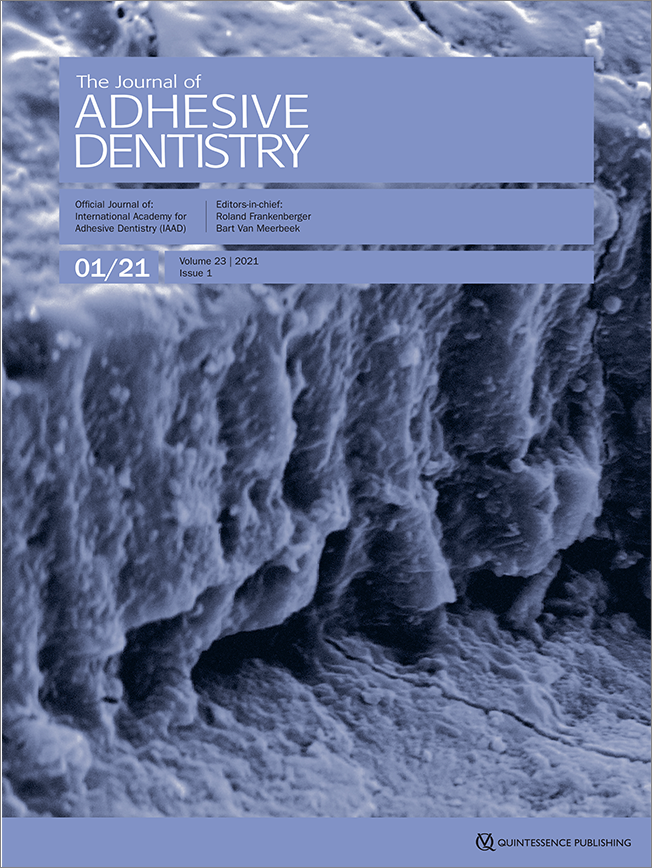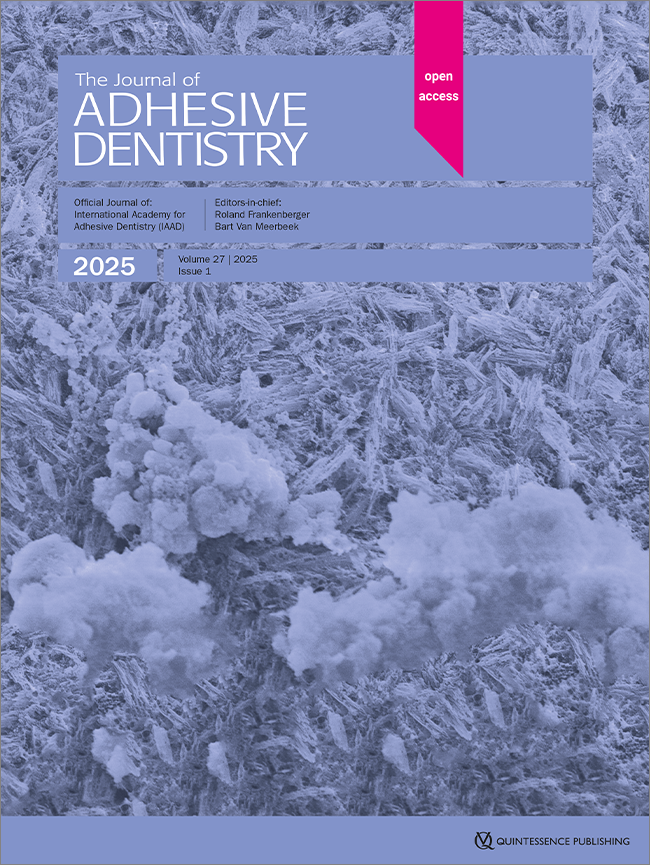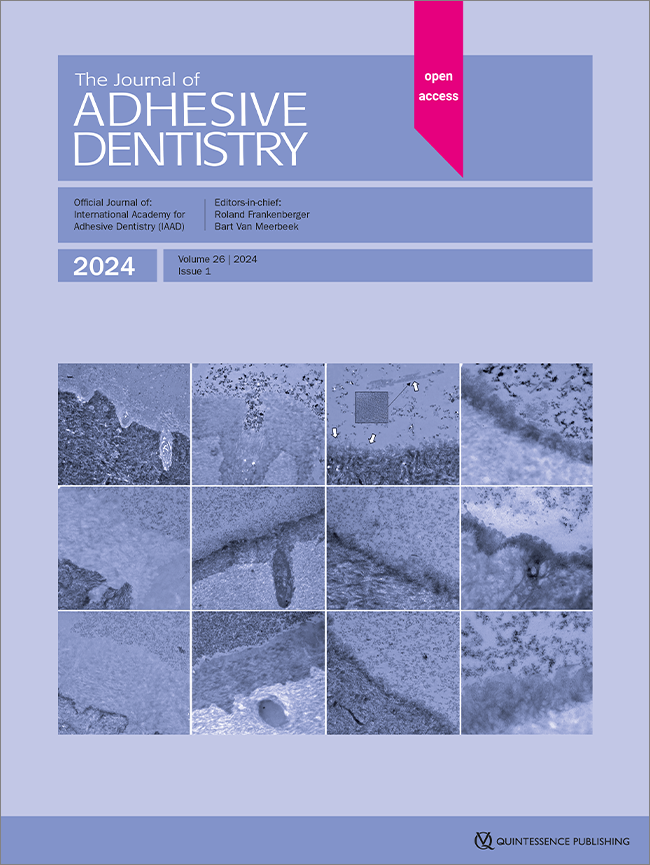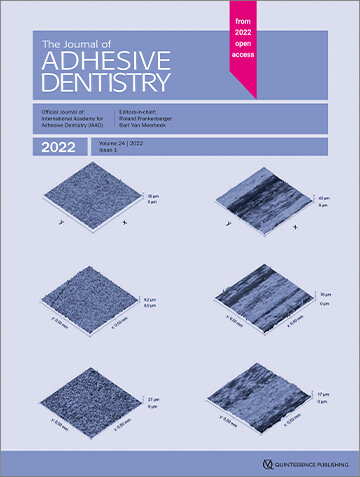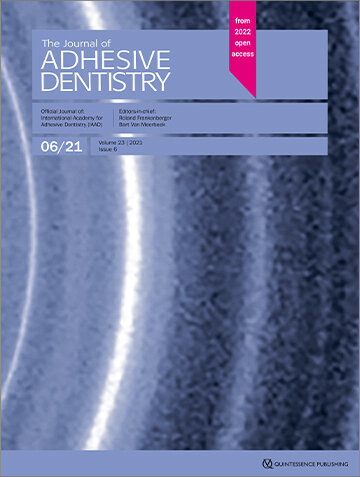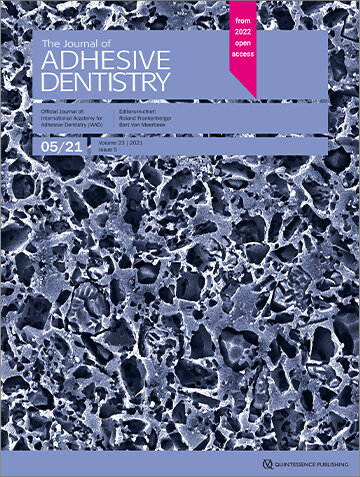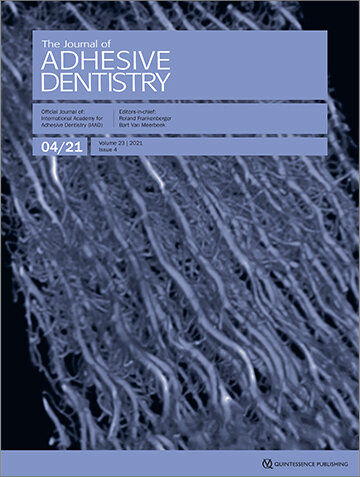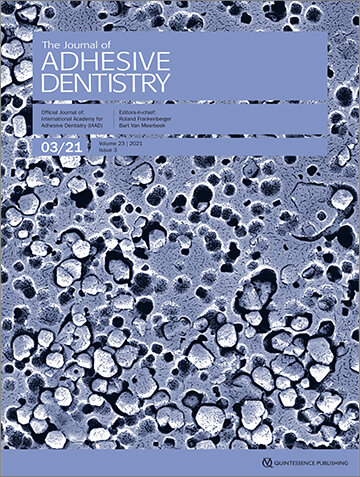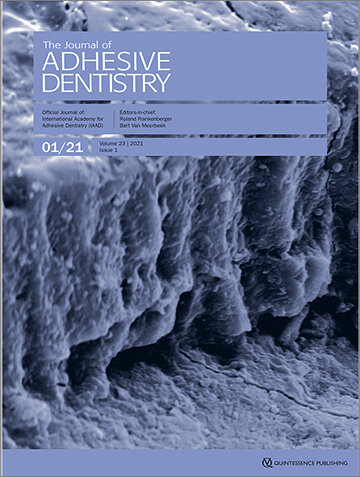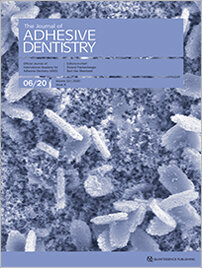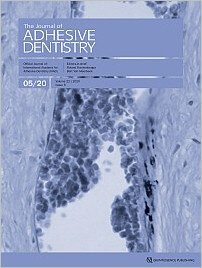Open Access Online OnlyClinical ResearchDOI: 10.3290/j.jad.c_1854, PubMed ID (PMID): 399034734. Feb 2025,Pages 1-7, Language: EnglishSrichai, Sutasinee / Saikaew, Pipop / Sattabanasuk, Vanthana / Senawongse, PisolObjective: To evaluate the effect of pre-procedural antiseptic mouthwashes on dentin bond strength of different adhesive systems. Methods: Flat occlusal dentin surfaces from 120 extracted human molars were randomly divided into four groups according to mouthwashes (0.12% chlorhexidine = CHX, 1% hydrogen peroxide = HP, 0.2% povidone-iodine = PI, and no mouthwash/control) and three subgroups of adhesives used (Clearfil SE Bond; CSE, Single Bond Universal = SBU in etch-and-rinse (ER) or self-etch (SE) modes) (n = 8). Composite resin was built up, and all bonded teeth were stored in 37°C distilled water for 24 h. Stick-shaped specimens were prepared and subjected to microtensile bond strength (µTBS) test. Failure mode analysis was determined using a light microscope. A resin-dentin interface was observed using scanning electron microscopy (SEM, n = 2). Elemental analysis in the PI group was further examined by SEM with energy-dispersive X-ray spectroscopy. The µTBS data were statistically analyzed by two-way analysis of variance (ANOVA) and Duncan’s multiple comparison (P < 0.05). Results: Rinsing with PI followed by SBU-SE demonstrated significantly higher µTBS than the control group (P < 0.05). Rinsing with HP showed significantly lower bond strength for CSE (P < 0.05). However, the effect of adhesive systems was not observed for all mouthwashes used (P > 0.05). SEM/EDX revealed the iodine deposition in the underlying dentin, where the highest amount of iodine was found for SBU-SE. Conclusion: CHX and PI can be recommended as pre-procedural antiseptic mouthwashes since they show no negative impact on µTBS for all tested adhesives. The dentin bond strength of CSE is hampered in the HP mouthwash group, and this should be a concern for the use of self-etching adhesive afterward.
Keywords: adhesion to dentin, adhesive, dentin, microtensile bond strength, pre-procedural antiseptic mouthwash
Open Access Online OnlyClinical ResearchDOI: 10.3290/j.jad.c_1865, PubMed ID (PMID): 399184187. Feb 2025,Pages 9-19, Language: EnglishHofmann, Maria / Wolf, Emma / Lücker, Susanne / Frankenberger, Roland / Wöstmann, Bernd / Krämer, NorbertPurpose: The aim of this study was to evaluate the marginal quality and wear of bulk-fill composite resins (BFs) for Class-II restorations of primary and permanent molars in comparison to a conventionally layered composite resin (RC) and to compare the results of the two dentitions. Materials and Methods: Eighty (40 primary and 40 permanent) extracted molars received standardized Class-II cavity preparations and were restored with either one of two flowable BFs, one of two high viscous BFs, or a composite resin (RC). Thermomechanical loading (TML; 2,500 cycles +5°C/+55°C; 100,000 cycles, 50N, 1.67Hz) followed. A quantitative marginal analysis using SEM images and a profilometric quantification of two-body wear were carried out using replicas. ANOVA, Kruskal–Wallis, Mann–Whitney U, and Wilcoxon signed-rank tests were used for statistical analysis (P < 0.05). Results: For both dentitions, a significant reduction of perfect margins was observed after TML (P < 0.02). For the primary dentition, the flowable BFs showed significantly less perfect margins than all high viscous materials (P < 0.005). For the permanent dentition, RC showed significantly fewer gaps than the flowable BFs (P < 0.04). Regarding wear, within the dentitions, no significant differences could be computed between groups with regard to the maximum height loss (P < 0.05). Conclusion: All of the investigated bulk-fill composite resins showed satisfactory in-vitro results for both tested parameters in primary and permanent teeth, with a superiority of the high-viscosity materials in terms of marginal quality.
Keywords: bulk-fill composite resins, marginal quality, permanent teeth, primary teeth, restoration materials, wear
Open Access Online OnlyCLINICAL MEDICINEDOI: 10.3290/j.jad.c_1871, PubMed ID (PMID): 4006307710. Mar 2025,Pages 21-29, Language: EnglishReymann, Josephine / Narayanan Ramakrishnan, Anantha / Ludtka, Christopher / Hey, Jeremias / Kiesow, Andreas / Schwan, StefanPurpose: The current trend in denture adhesives is shifting toward zinc-free formulations due to the significant health concerns associated with zinc. Studies have focused on the retention of these zinc-free denture adhesives; however, there is a dearth of literature regarding their damping performance. This study analyzes the impact of oral cavity physiological parameters: temperature, pH, and swelling ratio on the mechanical properties of zinc-stabilized and zinc-free denture adhesives and examines the role zinc plays in influencing the adhesive behavior. This study investigates how underlying mechanical properties of adhesive cream change for zinc-stabilized and zinc-free denture adhesives. The relative damping and its variation from exposure to physiological conditions in the oral cavity can significantly assist in the design of dentures to reduce the discomfort experienced by denture wearers. Materials and Methods: The relative damping of the zinc-stabilized and zinc-free denture adhesives was investigated with the loss modulus values, which were evaluated using rheological frequency sweep tests. The tests were performed by maintaining the denture adhesives at specified values of temperature, pH, and swelling ratio, and over a frequency range of 0.01 Hz to 10 Hz, which included the average frequencies of human chewing / bite forces reported in existing literature. Results: Zinc-stabilized denture adhesive showed a larger fluctuation of loss modulus values compared to the zinc-free formulation with respect to pH, temperature, and swelling ratios. The zinc-free denture adhesive showed higher damping behavior at frequencies below 0.7 Hz, whereas the zinc-stabilized denture adhesive showed higher damping behavior above loading frequencies of 0.7–1 Hz. Both the adhesives showed varying behavior on either side of the bite force spectrum in terms of relative damping of the applied bite. Conclusions: The damping or cushioning effect provided by denture adhesives can reduce pain experienced and assist dental practitioners in better supporting denture wearers.
Keywords: bite force, damping, denture retention, physiological parameters, zinc-free denture adhesive
Open Access Online OnlyResearchDOI: 10.3290/j.jad.c_1951, PubMed ID (PMID): 401784073. Apr 2025,Pages 31-42, Language: EnglishCarvalho, Thiago Saads / Baumann, Tommy / Said Zayed, Mohamed Ahmed / Loguercio, Alessandro D. / Peutzfeldt, Anne / Niemeyer, Samira HelenaPurpose: To modify phosphoric acid (PA) with polyphenol-rich plant extracts and verify their effect on immediate (24 h) and long-term (1 year) micro-shear bond strength (µSBS) of an adhesive system to sound and eroded dentin. Materials and Methods: 420 dentin specimens (360 for µSBS and 60 for characterization) were prepared and divided into two substrate-subgroups: sound (untreated) and eroded dentin (underwent 10 cycles of 1 h exposure to human saliva and 5 min immersion in citric acid). The specimens from each subgroup were randomly distributed into six groups, according to PA (n = 30/group): PA-EXP (experimental control), PA-GSE (PA-EXP + grape seed extract), PA-BLU (PA-EXP + blueberry extract), PA-CRA (PA-EXP + cranberry extract), PA-GRE (PA-EXP + green tea extract), PA-COM (commercial control). After etching with the respective PA (15 s), specimens were restored with adhesive and composite resin. Half of the specimens of each group were subjected to µSBS testing after 24 h and the other half after 1 year of storage (tap water, 37°C). Analyses were made with three-way ANOVA and post-hoc Tukey tests (α = 0.05). Results: Higher µSBS was observed to sound dentin than to eroded dentin, regardless of the storage time, except for PA-BLU and PA-GSE after 1 year (p = 0.40 and p = 0.10, respectively). After 24 h, for both substrates, PA-COM presented statistically significantly lower µSBS than the other PAs. After 1 year, µSBS was significantly reduced for all groups except for the PA-COM (sound: p = 0.67; eroded: p = 0.13). Conclusion: Compared to the commercial PA, the modified PAs improved the immediate µSBS and gave similar long-term µSBS to sound as well to eroded dentin.
Keywords: bond strength, cross-linkers, dental restoration, phosphoric acid, polyphenol, longevity, surface characterization
Open Access Online OnlyClinical ResearchDOI: 10.3290/j.jad.c_1953, PubMed ID (PMID): 401784083. Apr 2025,Pages 43-51, Language: EnglishPiemjai, Morakot / Lerttriphob, Thanyarat / Jariyapayuklert, Carat / Garcia-Godoy, FranklinPurpose: To investigate the dye penetration distance at Class V tooth-restoration margins/interfaces prepared in the labora-tory and orally using a primerless wet technique and MMA-TBB bonding resin with or without 4-META monomer promoter. Materials and Methods: A box-form cavity at the cementoenamel junction was prepared on extracted human premolars and vital teeth scheduled for extraction for in-vitro and in-vivo studies, respectively. For each vital cavity, 1% citric acid and 1% ferric chloride aqueous (1-1) conditioner was applied for 10 s, 30 s, or 60 s, rinsed off and blot-dried, and was then bonded with either 4-META/MMA-TBB or MMA-TBB resin and bulk-filled with light-cured composite resin (n = 10). Restored vital teeth continued to function in the oral cavity for seven days before extraction. Restorations were stored in water at 37°C and 0.5% basic fuchsin dye solution for 24 h each before dye penetration measurement under a microscope, while a hybrid layer was observed using a scanning electron microscope (SEM). Results: No hypersensitivity or pain occurred in any vital teeth. For all 1-1 groups, no dye penetration was detected at any margins of the in- vitro restorations. Dye penetration (0.13 mm) was only observed in one intraoral restoration of 60 s etching with MMA-TBB resin at the cementum/dentin margin. A consistent hybrid layer after chemical modification was observed in leakage-free specimens. Conclusion: The results suggest that the 1–3 µm 1-1 demineralized substrate clinically provides sufficient permeability to form a microleakage-free hybrid layer using a primerless wet technique with MMA-TBB or 4-META/MMA-TBB resin. Intraoral microleakage-free restorations may lead to longer-term restored-tooth survival.
Keywords: intraoral microleakage-free restoration, MMA-TBB resin, primerless wet technique, 4-META/MMA-TBB resin, hybrid layer, tooth hypersensitivity
Open Access Online OnlyClinical ResearchDOI: 10.3290/j.jad.c_198816. Apr 2025,Pages 53-64, Language: EnglishJanson, Malin / Bassier, Vanessa / Liebermann, Anja / Schoppmeier, Christoph Matthias / Gregorio-Schininà, Maria DiPurpose: This in-vitro study evaluated the effect of universal adhesives and sandblasting with 50 μm and 110 μm aluminum oxide particles (Al2O3) on the shear bond strength (SBS) between composite and zirconia in repair applications across different aging intervals. Materials and Methods: 1296 zirconia specimens (Katana Zirconia HT) were randomized into three main groups: (A) sandblasting with 50 μm Al2O3, (B) sandblasting with 110 μm Al2O3, and (C) control. Each group was further divided into six subgroups: OPB (Optibond Universal), PBA (Prime&Bond Active), IBU (iBond Universal), CUBQ (Clearfil Universal Bond Quick), MBP (Monobond Plus), and SBUP (Scotchbond Universal Plus). Composite (Clearfil Majesty ES-2 Universal) was applied, and SBS (MPa) measured at baseline (24-h storage) at 30 and 90 days, and after 7 days + 5000 thermocycles (5–55°C). Failure modes were assessed at 40 × magnification. Analysis used a generalized linear model (GLM) with Bonferroni adjustment (α 0.05). Results: Sandblasting significantly increased SBS compared to controls, with Group B showing the highest durability after thermocycling, with values decreasing over aging periods. In Groups A and B IBU (21.43 ± 2.7 MPa; 25.60 ± 5.78 MPa), SBUP (19.26 ± 3.2 MPa; 23.62 ± 4.4 MPa), and CUBQ (19.92 ± 2.8 MPa; 22.75 ± 4.34 MPa) achieved the highest SBS, with adhesive failures being predominant and cohesive failures mainly in high-SBS subgroups. Conclusion: Pretreatment with Al2O3 significantly enhances composite-zirconia bond strength, with larger grit sizes more effective. MDP-containing adhesives are recommended for reliable zirconia repairs.
Keywords: repair, shear bond strength, universal adhesives, zirconia
Open Access Online OnlyCLINICAL MEDICINEDOI: 10.3290/j.jad.c_196616. Apr 2025,Pages 65-74, Language: EnglishEtiennot, Line / Ordies, Michiel / Yao, Chenmin / Mercelis, Ben / Peumans, Marleen / Van Meerbeek, BartPurpose: The study aimed to measure the efficacy of 10-methacryloyloxydecyl dihydrogen phosphate (10-MDP) saliva-decontamination protocols by measuring bonding effectiveness to saliva-contaminated dentin following different surface-decontamination protocols. Materials and Methods: The micro-tensile bond strength (µTBS) of the two-step self-etch (SE) adhesive Clearfil SE Bond 2 (‘CSE2’, Kuraray Noritake) and the one-step SE adhesive Clearfil Universal Bond Quick (‘CUBQ’, Kuraray Noritake) to saliva-contaminated bur-cut dentin was measured when saliva-contaminated dentin was decontaminated by either the 10-MDP-containing Katana Cleaner (‘KC’, Kuraray Noritake) or CSE2 primer (‘CSE2p’), with bonding to saliva-contaminated (‘saliva(–)’) and non-contaminated dentin (‘clean(+)’) having served as negative and positive control, respectively. Half of the specimens were subjected to µTBS testing ‘immediately’ after 1-week water storage, while the other ‘aged’ half was tested after 50,000 thermocycles. Statistics involved linear mixed modeling (LMM) with restricted maximum likelihood (REML) estimation (α = 0.05). Results: Overall, the two-step SE adhesive CSE2 outperformed the one-step SE adhesive CUBQ. Saliva-contaminated dentin was most effectively decontaminated when CSE2p was applied with both adhesives, closely followed by KC decontamination. Notably, CSE2 demonstrated satisfactory performance even without separate decontamination. Conclusion: Unaltered bonding to saliva-contaminated dentin was achieved upon surface decontamination with CSE2p and KC. Using CUBQ, additional decontamination with either CSE2p or KC is strongly recommended. In the case of CSE2, no additional decontamination agent is required.
Keywords: adhesive, bond strength, decontamination, Katana Cleaner, saliva






